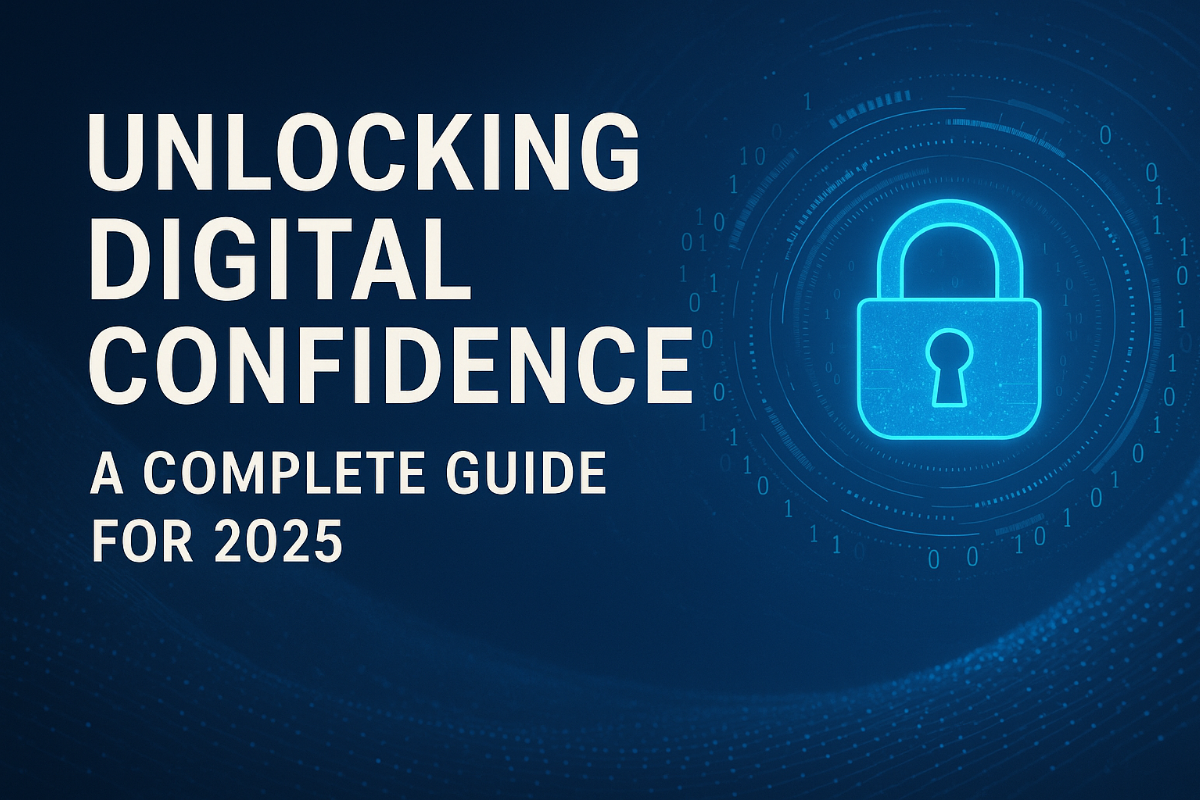What is Digital Confidence?
Digital confidence refers to the ability to comfortably and effectively use digital tools, platforms and technologies. It’s more than just technical skills—it’s about feeling empowered in control, and capable in an ever-evolving digital landscape.
At its core, it’s about:
- Understanding how to use digital tools effectively.
- Navigating the internet safely.
- Adapting to new tech with ease.
- Communicating clearly and responsibly online.
Why Digital Confidence Matters in 2025
Digital confidence is becoming the digital literacy of the future. Here’s why it matters more than ever:
- Remote Work & Hybrid Learning: Workplaces and classrooms are digital by default.
- Online Identity & Presence: Personal branding and social credibility rely heavily on digital fluency.
- Cybersecurity Awareness: Knowing how to protect yourself online is now essential.
- Access to Services: From banking to healthcare, most services are online.
Being digitally confident ensures you don’t get left behind and allows you to take full advantage of digital opportunities.
Barriers to Digital Confidence
Many people struggle with digital confidence due to a mix of psychological and technical barriers:
1. Fear of Technology
The fear of making mistakes or breaking something often stops people from exploring digital tools.
2. Lack of Exposure
If you weren’t raised in a tech-heavy environment, digital interfaces can seem foreign.
3. Negative Online Experiences
Cyberbullying, scams, or confusing platforms can erode confidence.
4. Information Overload
The sheer volume of tools, updates, and jargon can be overwhelming.
How to Unlock Digital Confidence
Let’s break down five proven strategies to build lasting digital confidence.
1. Master Digital Literacy
Digital literacy is the foundational skill for digital confidence. It involves:
- Basic Tech Skills: Understanding how to use devices, apps, and software.
- Internet Navigation: Using search engines, identifying credible sources, bookmarking tools.
- Privacy & Security: Knowing how to create strong passwords, detect phishing attempts, and use VPNs.
Tools to Try:
2. Build a Safe Digital Environment
A secure digital space encourages confidence:
- Install Antivirus Software
- Use Multi-Factor Authentication (MFA)
- Regularly Update Devices and Apps
- Avoid Public Wi-Fi for Sensitive Transactions
Pro Tip: Use password managers like 1Password or LastPass to keep track of your login credentials securely.
3. Embrace a Growth Mindset
Confidence comes from progress, not perfection. A growth mindset encourages:
- Trying new tools without fear
- Learning from mistakes
- Staying curious
Mindset Shift: Instead of “I’m bad at tech,” say, “I’m learning how to use this tool better.”
4. Leverage Tools That Empower
Using the right tools can turn frustration into confidence:
- Communication: Zoom, Slack, Teams
- Project Management: Trello, Asana, Notion
- Productivity: Google Workspace, Evernote
- Accessibility: Grammarly, screen readers, text-to-speech tools
Get Comfortable: The more you use these tools in everyday life, the more fluent and confident you’ll become.
5. Practice Digital Etiquette
Knowing how to communicate online is just as important as knowing what tools to use.
- Be concise and respectful in emails and messages.
- Understand the tone of different platforms (e.g., LinkedIn vs. Instagram).
- Avoid sharing false or misleading information.
Remember: Confidence is built on competence and respect in digital spaces.
Real-Life Benefits of Digital Confidence
When digital confidence grows, so do your opportunities:
- Career Growth: Confident digital communication and tech skills are in high demand.
- Reduced Stress: No more panic over Zoom meetings or password resets.
- Better Relationships: Stay connected with friends, family, and professional networks.
- Continuous Learning: More openness to online courses, webinars, and upskilling.
Top Tools & Resources to Boost Digital Confidence
Here are some hand-picked tools and platforms that empower digital growth:
| Category | Tool/Platform | Purpose |
|---|---|---|
| Learning | LinkedIn Learning | Upskill professionally |
| Security | NordVPN, Bitdefender | Online privacy & device protection |
| Productivity | Notion, Evernote | Organization & note-taking |
| Collaboration | Google Workspace, Zoom | Communication & teamwork |
| Accessibility | Grammarly, Otter.ai | Writing and transcription help |
Final Thoughts: The Future of Digital Confidence
As we move deeper into the 2020s, digital confidence will be as essential as reading and writing once were. It empowers people to:
- Make informed decisions
- Navigate their careers and lives confidently
- Adapt to emerging technologies like AI and blockchain
Whether you’re just starting or leveling up, the journey to unlocking digital confidence is ongoing—and it’s more rewarding than ever.
FAQs
What is digital confidence in simple terms?
Digital confidence is feeling comfortable and capable when using technology and digital tools, whether for work, communication, or daily tasks.
Who needs digital confidence?
Everyone! From students to seniors, digital confidence helps individuals navigate today’s tech-driven world with ease and safety.
How can I improve my digital confidence quickly?
Start small: take a digital literacy course, use one new tool at a time, and practice regularly. Surround yourself with supportive resources and communities.
Is digital confidence the same as digital literacy?
Not exactly. Digital literacy is the skillset; digital confidence is the mindset. You need both to thrive in digital spaces.
What role does digital confidence play in career success?
It enhances your ability to collaborate, adapt to new tools, and stand out in increasingly tech-centric job markets.





